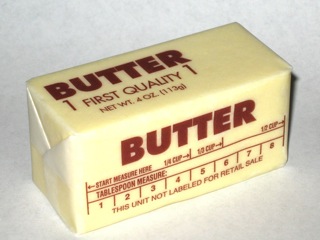Butter Measurements:
Here in the United States, butter is usually packaged in one pound boxes.A box will have 2 cups of butter in it.
There will be 4 individually wrapped sticks of butter in a one pound box.
Each stick is ½ cup of butter.
½ cup of butter is 8 tablespoons.
The wrapper will usually have a measuring line on it, divided into 8 tablespoon measurements.
The measuring line will show ¼ cup as 4 tablespoons.
⅓ cup will be 5⅓ tablespoons.
Once you have established the measurement you need, place the stick of butter on the measuring line and cut through the butter with a table knife.
Butter Storage:
Boxes of butter will have an expiration date stamped on them.Keep butter stored in a refrigerator. It will keep up to the expiration date as long as it is in it's wrapper.
Butter in a butter dish can be kept at room temperature for several days before going rancid. Salted butter keeps better at room temperature because the salt acts as a preservative.
How will you know if your butter has gone rancid? If it has a strong smell or tastes stale and bitter it is probably rancid.
You can freeze butter for up to 6 months, although freezing may change the texture and impair the flavor.
Salted Butter:
Salted butter generally keeps 2 to 4 weeks longer than unsalted butter.If you are using salted butter, you will need to reduce the amount of salt you add to a recipe.
If a recipe calls for ½ teaspoon of salt and you are using salted butter, you will probably only need to use about ⅛ teaspoon of salt.
Unsalted Butter:
When should you use unsalted butter? If you have dietary restrictions where you need to limit the intake of salt, then unsalted butter is a good choice.If you are making pastries, like croissants, then unsalted butter will give you a much richer flavor. You will be able to control the amount and taste of salt in your pastry dough.
If you are using unsalted butter and you do not have dietary restrictions related to salt intake then go ahead and use the amount of salt suggested in a recipe.
What is Room Temperature Butter?:
When you touch room temperature butter your finger will leave a mark in it, but it will not feel soft or greasy. Leave a cube of butter out for 30 minutes to 1 hour to bring it to room temperature.What is Softened Butter?:
When you touch softened butter your finger will leave a deep indentation. A cube of softened butter can be picked up without if falling apart. Leave a cube of butter out for 30 minutes to 1 hour to bring it to a softened state.What is Soft Butter?:
Soft butter will be too soft to pick up with your fingers. A cube of butter left out for 24 hours will be soft butter.Methods For Softening Butter:
Most recipes for baked goods call for "softened butter". This means soft to the touch, but not melted to the point where it is liquid in form.Of course, the best way to soften butter is to leave it at room temperature for approximately 30 minutes to 1 hour.
If you have a microwave, you can use it to soften butter. This would be done in cases when you forget to get butter out ahead of time and you are in need of softened butter.
One cube of butter, left in it's wrapper, can be placed in the microwave for 10 seconds and it will be softened.
Methods For Melting Butter:
Melting butter can be tricky, as you do not want to burn it.There are 2 methods I use frequently to melt butter:
- Microwave the butter in a bowl covered with wax paper for 30 seconds. If you then let it sit for 10 to 15 seconds it will usually melt completely if it has not already done so. If it does not completely melt, microwave in 10 second intervals until the butter is liquid.
- Place the butter in a small pot or heavy duty stainless steel measuring cup. Heat the butter up on the stove using the lowest possible heat setting. You must keep an eye on the butter and stir it occasionally so it does not burn.

Creaming Butter:
What does it mean to cream butter? Many recipes for baked goods direct you to cream the butter.Creaming means to take slightly softened butter and mix it on a medium-high speed or beat it by hand vigorously until it is creamy. The consistency will be like a stiff frosting.
Usually, once the butter is creamed, you add the required amount of sugar and then mix on medium-high speed or beat vigorously by hand, until it has a light fluffy texture. The color will lighten up, as well.


